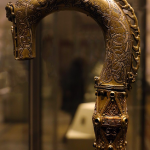If you study Church History long enough, you find a lot of interesting trivia that never fits into books or lectures. One of them is the history of clerical garb. Many young priests today tend to be more traditional, and it’s not unusual to find some sporting a cassock, a biretta, or even the old vestments known as “fiddlebacks.” In doing so, they point back to a period when this was the norm. But for most of the 1800’s, Catholic priests in the United States actually wore suits and ties were addressed as “Mister” rather than “Father.” This was a holdover from the English Catholic tradition, where “Roman” clergy tried to make themselves as inconspicuous as possible in an anti-Catholic climate. Things weren’t much better in mid-19th century America. Even women religious weren’t immune to this trend. When the Sisters of St. Joseph first came to Brooklyn in 1856, for example, they wore civilan garb lest they be attacked on the street by Nativists. (Not long before, without provocation, a man walked up to a Sister of Charity in the streets of Boston, called her a “damned papist bitch,” and slapped her face.) In 1884, at the Third Plenary Council of Baltimore (which also gave us the Baltimore Catechism), clerical garb was mandated. But by that time, anti-Catholics in America had abated, and the cassock and the biretta became more common. (The image on the left shows Father Sylvester Malone, Pastor of SS. Peter & Paul Church, Williamsburg, in 1854.)

.jpg)














